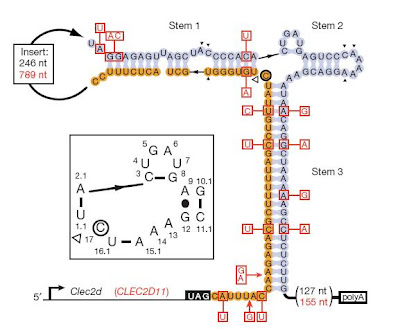Source: Brauer, M.J., Huttenhower, C., Airoldi, E.M., Rosenstein, R., Matese, J.C., Gresham, D., Boer, V.M., Troyanskaya, O.G., and Botstein, D. Coordination of growth rate, cell cycle, stress response, and metabolic activity in yeast. 2008. Molecular Biology of the Cell, 19: 352-67
The authors ran 36 samples (6 growth rates on 6 nutrient limitations, including two auxotrophs) and measured global transcript levels at and steady-stage growth. They looked to see if gene expression could be a linearly correlated with growth rate and found that for 27% of genes, this appeared to be the case. Auxotrophs limited for phosphate or nitrogen showed cell arrest and normal levels of glucose and ethanol in the media, but when limited for their auxotrophy showed high fermentation with greatly enhanced levels of ethanol present. The authors hypothesize that there are two metabolic controls: one that’s independent of nutrient type, limits based on cell growth without full arrest while the other senses a natural nutrient starvation and fully arrests the cell. The authors also compare their gene sets of positively and negatively correlated genes to gene sets from stress response, cell cycle periodicity and yeast metabolic cycle periodicity. They find that most of the genes positively correlated with growth rate are found in stress repressed conditions and mitochondrial and cytosolic ribosome clusters from YMC. While genes negatively correlated to growth rate are found in stress induced and peroxisomal clusters from YMC. They suggest that these genes are mainly responding to instantaneous growth rates and not the particular condition tested. Building a model off this presumption, they are able to more-or-less recreate the growth rate from transcript data from Brauer et al 2005 involving the diauxic shift. Much of their significance for whether a gene is positively or negatively-correlated with growth comes from bootstrapping.

Figure 5. Transcriptional response of stress-related and cell cycle-related genes to changes in growth rate. x-axis: Slope of transcript abudance vs growth. Genes expressed periodically during the cell cycle (black line; Spellman et al., 1998) are distributed essentially as background, whereas genes induced (red line) or repressed (green line) by stress (Gasch et al., 2000) tend to be conversely repressed or induced as growth rate increases.
• Other notes:
-positively-correlated genes are enriched for ribosomal proteins
-auxotrophs don’t arrest when lacking their auxotrophic nutrient, but do when lacking a natural nutrient; also consume twice as much glucose
-5537 genes measured, 3049 fit linear model with growth rate, 1470 respond significantly to growth rate
-can play with sets of genes at http://growthrate.princeton.edu
=GO enrichment – negative: energy metabolism, oxidative metabolism, oxioreductase activity, peroxisome
=positive: mitochondrial protein import, translation, ribosome biogenesis, rRNA metabolism
-ESR genes may be responding not to stress but to instantaneous growth rate
-cell-cycle genes had same distribution as total gene set
=only M-G1 phase was slightly enriched for negative correlation with growth rate
•slower growing cells spend more time waiting for division signal
-yeast grown in batch on poorer nutrient sources had better stress response
=this supports the theory that ESR-induced genes are just slow-rate genes, these cells were already growing slowly so they did not change as dramatically
Although I find it intriguing to think that transcript abundance is more a response to growth rate than stress, I find some problems with that interpretation. Slower growing cells, goes the hypothesis, will respond better to stress since they already have the right transcript profile. BUT, slower growing cells spend a greater proportion of their life in G1 and G2, the energy-producing stages. This means they are already subject to more stress per cell cycle, and thus that is the reason the Stress/Slow Growth profile is already up. In the end, maybe it's semantics unless we can start to find stress-specific profiles.





